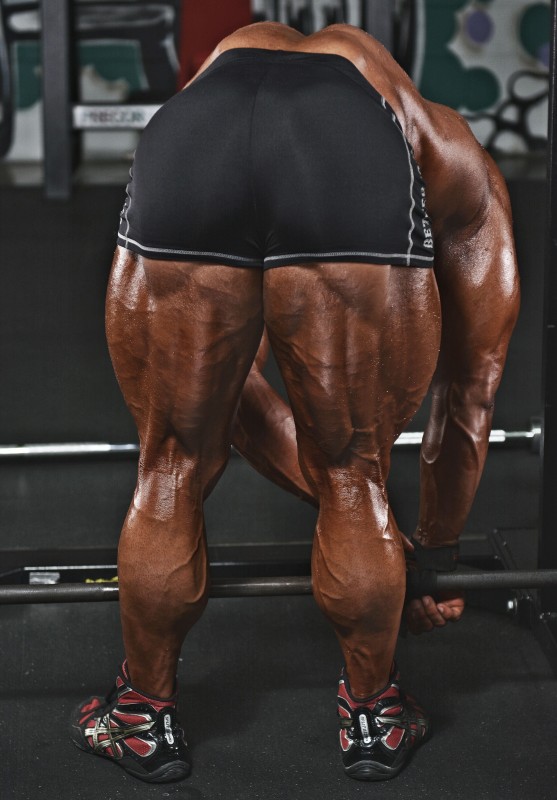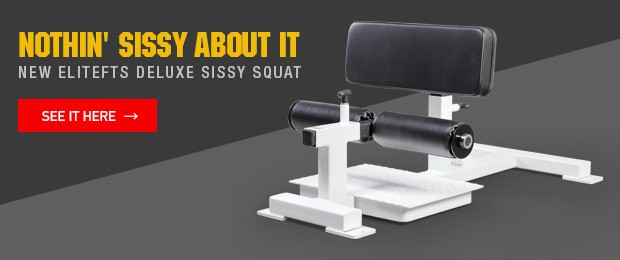
Every lifter on the planet has a muscle or two that simply won’t seem to grow or become stronger, despite your best efforts.
Regardless of what tricks and obscene amounts of volume you throw at yourself, trying to win the war against a stubborn muscle is much the same as ramming your head into a wall, over and over.
After years of learning from countless coaches, self-experimentation, and imparting many of the lessons learned onto clients, a trend has appeared. A trend of which muscle is often the most underwhelming.
Along with your calves, it’s your hamstrings that are likely to be one of your most stubborn (and oft-neglected) body parts.
Between many lifters opting for quad-dominant leg days (honestly, I don’t blame you) and the assumption that a few token sets of leg curls will be enough to trigger growth, there’s a rampant affliction throughout gyms across the nation that leaves many a hamstring to be desired.
RECENT: Toothpicks to Horseshoes — How to Build MASSthetic Triceps
Yet, it’s not (entirely) your fault.
While it’s one thing to have to physically *train* your hamstrings, training them won’t matter if you go about doing so in all the wrong ways (this goes back to the few token sets).
Enter the following tips that you can start using immediately to effectively train your hamstrings, and find yourself sitting a few inches taller when you sit down.
Hamstrings Hack #1
Apply the Law of Specificity to your training, and begin each leg session with leg curls.
If you’re like most quad dominant lifters strutting amongst the squat racks, it’s all but guaranteed that your hamstrings are underwhelming, weak, and a royal pain in the ass to even *feel* working.
Fortunately, you’re not without a few tools in your belt. Tools which you can use to bring your wheels up to speed in short order.
Foremost, you can apply the law of specificity to your leg sessions, and tap into muscle-building prowess to bring up your lagging hamstrings. By tackling your leaving-much-too-be-desired hamstrings first in your session, you gain the advantage of stimulating them when you’re fresh, full of energy, and able to squeeze out every ounce of effort, and thrash every muscle fiber you can. At least to a much greater degree than the few token sets that you often tack onto the tail end of your typical leg day.
Second, a massive part of the reason you’re likely struggling to develop your hamstrings is because you lack muscular innervation in your hamstrings. Which is another way saying that your mind-muscle connection, and your ability to “feel” and contract a muscle under load may or may not leave much to be desired.
This is yet another nod to the importance many bodybuilders place on creating intramuscular tension and placing much of their focus on “feeling each rep.”
Often times, this lack of innervation simply comes down to rarely — if ever — training said muscle. When it comes to hamstrings, this is often the case. Because let’s be real, leg curls for as fun as they are, aren’t the sexiest or most exciting of exercises.
Third, an integral part of assaulting your legs, building muscle, and doing so over the long haul, is keeping your hips and knees healthy over the long-term. The more weight you can add to the bar in your squats — typically — the more stress is placed on your lower back, knees, hips, and the joints, ligaments, and tendons that are intertwined throughout.
By beginning your session with leg curls, you’re able to kickstart blood flow, get your synovial fluid moving, and effectively grease your knees and hips for what’s to come later in your session.
For an added bonus, as a result of greasing your hips and knees by placing leg curls before squats, you’ll find that you have much greater stability in your heavy squat work. Not only that, but you’ll probably notice that you’ve got a little extra “pop” in your squat that wasn’t there before.
Hamstrings Hack #2
Perform unweighted isometric contractions between sets of leg curls (or squats).
To follow up on the importance of enhancing your mind-muscle connection, standing, isometric leg curls with merely your bodyweight are a fantastic trick you can use to build your mind-muscle connection.
These are simple to execute and do wonders for your mind-muscle connection with your stubborn hamstrings.
The execution:
While you’re resting between sets of leg curls, (standing) simply keep your hips shoved forward, glutes flexed, and curl one leg up so that the back of your ankle presses hard into the pad. Flex your hamstring hard for 10 seconds before switching to the other leg.
Finish your rest period, and it’s back to your leg curls (you can also do these between sets of squats, leg presses, lunges, etc).
You can do these as often as you like. That said, after 3-4 rounds you should be good to go, with well-pumped hamstrings.
Hamstrings Hack #3
Place a plate between your feet, and perform an isometric contraction by digging in with your heels to recruit the entirety of your hamstrings.
If you subscribe to the typical list hamstring training work: leg curl variations, stiff legged deadlift variations, sumo deadlifts, Glute/Ham Raises, you’re only stimulating your hamstrings in two of their key functions, knee flexion, and hip extension. Meaning, you’re neglecting the role your hamstrings play in internal and external rotation of your legs.
This hamstring hack (when deployed correctly) works exceptionally well on barbell back squats and stiff-legged deadlift variations.
The execution:
Take a 10-25 pound plate (depending on the exercise and your biomechanics), and place it between your heels.
As you move through the eccentric portion of the exercise, isometrically dig your heels into the plate, while aiming to pull your toes away from one another, and pushing your knees outward.
When you place the plate between your feet and dig in hard with your heels, it provides an external cue in a situation where you’ve likely never had one. Thus, allowing you to illicit a powerful isometric contraction through your hamstrings, which you’d otherwise be missing out on.
As well, adding the plate between your feet jacks up the stimulation your hammies receive in both movements, on top of hitting them in two functions that are oft-neglected.
Try using this tip in your leg sessions for the next 4-6 weeks, and you’ll surely hamstring soreness like you’ve never felt before (top to bottom, side to side soreness is a unique feeling).
Hamstrings Hack #4
Finish your leg days with a hamstring-focused stretching movement.
The virtues of finishing any bodybuilding oriented session with a movement that stretches pumped and thrashed muscle fibers have been extolled over and over and over.
Which means there must be something to it.
(Perhaps Arnold was onto something…).
If you’ve never stretched a well-pumped muscle under load, you’re missing out on a whole world of wonderful, muscle-building pain.
In the context of your hamstring training, wrapping up your session with stiff legged deadlifts (dumbbell, barbell, smith machine), good mornings, or even a simple static stretch will put the finishing touches on your session, and allow for a massive rush of blood flow into your muscles.
The execution.
When laying out your leg day, ensure that you finish with one of the above exercises and that you use a tempo that encourages you to move a little slower and spend a few seconds emphasizing the stretch position. The load is not the focus here, form and execution are.
Hamstrings Hack #5
Treat each rep as its own set.
This should go without saying, but all too often treating each rep as it’s own falls by the wayside in favour of chasing heavier and heavier loads.
Hamstrings are a fickle, particular beast. In that, it’s far too easy to lose your connection with them mid-set. And if you threw a little more weight on the bar than you need, chances are you’re only going to get 2-3 quality reps out of your set. before your glutes start firing and form breaks down. That won’t do.
Treating each rep as it’s very own will help you to maximize each rep, and generate the most muscle fiber damage. If need be, take the time to reset yourself after each rep. Make sure your hip are locked down, glutes are tights, abs flexed, toes where you want them, and aim to curl by ‘pulling’ with you hamstrings.
The execution.
Use a little less weight than you normally would, and a make a conscious, focused effort to treat each rep as it’s own. Take a moment to pause in both the stretch and contracted position. Take a deep breath before beginning each rep. Move slowly, but deliberately, and with your glutes, hamstrings, and adductors flexed as hard as you can.
The Final Reps
When you boil it down, laying out a sound training program isn’t all that complex.
But what many a lifter tends to overlook amongst tempos, rest times, and reps, is the actual effort and purpose that goes into executing each rep.
“It’s not so much what you do, as it is how you do it.”
Take the time to learn how to optimize different exercises for your goals, training style, and preferences. Find ways to make exercises more effective. Always be experimenting, always be learning.
Image courtesy of Jeffrey Sygo












1 Comment